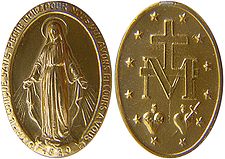Miraculous medal
The Miraculous Medal , also known as the Miraculous Medal , is an oval commemorative coin that was made in the 19th century in relation to an apparition of Mary reported by the Vincentian Sr. Catherine Labouré and was subsequently distributed in large numbers.
Sister Catherine experienced the first apparition of Mary , the Mother of God , on the night of July 18-19, 1830. During two apparitions on November 27th and December 1830, during the evening meditations, she saw the Mother of God , standing in an oval-shaped frame and standing on the globe, and the rings that the Blessed Mother wore bathed the globe in colored light. Around the frame appeared the words Ô Marie, conçue sans péché, priez pour nous qui avons recours à vous (“O Mary, receive without sin, pray for us who take refuge in you”). While Sr. Catherine was still looking, the oval frame formed twelve stars, a capital M on top of a cross, and they stylizedHearts of Jesus and Mary ; this motif is embossed on the reverse of the medal. According to Sr. Catherine, the Blessed Mother told her that her mission was to have a medal made with these motifs. All who trust them would receive great graces. The apparition said that the rays were "the symbol of the graces that I pour out on those who ask me."
At first, Father Aladel, Labouré's confessor , with whom she was supposed to speak about it, did not believe in the authenticity of the apparition. It was not until 1832, after two years of examining the matter, that Fr. Aladel obtained permission from the Archbishop of Paris, Hyacinthe-Louis de Quélen , to make the medals without giving Sr. Catherine's name. The goldsmith Adrien Vachette designed the medal.
Reports of miraculous healings associated with the medal led to the name Miraculous Medal . Anyone who has this displayed by a priest can acquire a perfect indulgence on this day and subject to fulfillment of further indulgence conditions on the feast of the apparition of the Miraculous Medal on November 27, on Easter, on the feast of the Immaculate Conception and on the day of his death . Miraculous medals are often very small. Since they are inexpensive and often produced in large numbers, they can be purchased cheaply in places of pilgrimage or received as a gift. The Engelwerk ascribes a "widely known radiance" to the medal. His member Karl Maria Harrer published numerous brochures about alleged miracles.
The chapel in which the apparitions are said to have taken place is in the mother house of the Vincentian Sisters of Paris. In this chapel are also the relics of Catherine Labouré and St. Luise of Marillac .
literature
- Maria Cuylen: Saint Catherine Labouré and the Miraculous Medal of the Immaculate. Kanisius, Freiburg 2000, ISBN 3-85764-031-6 .
- René Laurentin : The life of St. Catherine Labouré. Gratia, Graz 2007, ISBN 978-3-9502316-0-1 (French edition 1980).
Individual evidence
- ↑ Work of the holy angels: The manual of the angel work. Innsbruck 1961, page 182
- ^ Karl Maria Harrer: Experiences with the miraculous medal today (20). Miriam Verlag , Jestetten 1986, ISBN 9783874493475
